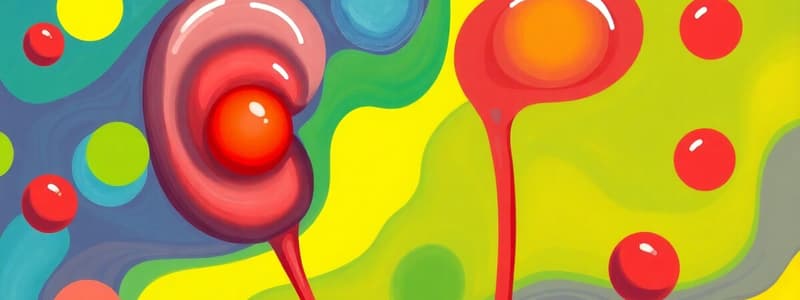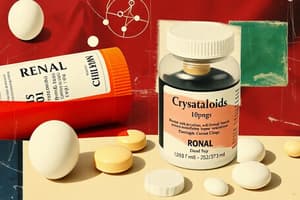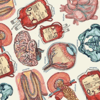Podcast
Questions and Answers
Which intravenous solution is classified as isotonic?
Which intravenous solution is classified as isotonic?
- 0.45% NaCl
- 3% NaCl
- 0.9% NaCl (correct)
- D10W
What is the primary effect of hypotonic solutions on fluid movement?
What is the primary effect of hypotonic solutions on fluid movement?
- Fluid moves into veins from surrounding tissues.
- Fluid expands the plasma volume significantly.
- Fluid moves out of veins into surrounding tissues. (correct)
- Fluid remains in the bloodstream.
Which of the following is a characteristic of crystalloids?
Which of the following is a characteristic of crystalloids?
- They promote urinary flow and are used for hydration. (correct)
- They increase the risk of viral transmission.
- They are effective for expanding plasma volume.
- They contain proteins and electrolytes.
Which solution would cause fluid to move into the bloodstream from surrounding tissues?
Which solution would cause fluid to move into the bloodstream from surrounding tissues?
What is a common use of isotonic solutions in clinical settings?
What is a common use of isotonic solutions in clinical settings?
What is the primary mechanism by which osmotic diuretics increase urine output?
What is the primary mechanism by which osmotic diuretics increase urine output?
Which of the following common effects is associated with ACE inhibitors?
Which of the following common effects is associated with ACE inhibitors?
Which class of antihypertensive medications primarily decreases cardiac output?
Which class of antihypertensive medications primarily decreases cardiac output?
What is the primary action of angiotensin II receptor blockers (ARBs)?
What is the primary action of angiotensin II receptor blockers (ARBs)?
Which of the following is a common side effect of calcium channel blockers?
Which of the following is a common side effect of calcium channel blockers?
What effect do direct vasodilators primarily have on blood vessels?
What effect do direct vasodilators primarily have on blood vessels?
What is a common side effect of alpha-1 adrenergic blockers?
What is a common side effect of alpha-1 adrenergic blockers?
Which medication class is primarily used to manage increased intraocular pressure?
Which medication class is primarily used to manage increased intraocular pressure?
What condition is typically treated with the use of osmotic diuretics?
What condition is typically treated with the use of osmotic diuretics?
How do beta blockers affect the renin-angiotensin-aldosterone system (RAAS)?
How do beta blockers affect the renin-angiotensin-aldosterone system (RAAS)?
What distinguishes non-dihydropyridine calcium channel blockers from dihydropyridines?
What distinguishes non-dihydropyridine calcium channel blockers from dihydropyridines?
What is a potential side effect of abrupt discontinuation of alpha-2 agonists?
What is a potential side effect of abrupt discontinuation of alpha-2 agonists?
Which mechanism is primarily used by direct renin inhibitors to lower blood pressure?
Which mechanism is primarily used by direct renin inhibitors to lower blood pressure?
Which type of fluid is primarily used to increase oxygen carrying capacity in patients?
Which type of fluid is primarily used to increase oxygen carrying capacity in patients?
What is the primary mechanism of action for thiazide diuretics?
What is the primary mechanism of action for thiazide diuretics?
Which statement about carbonic anhydrase inhibitors is true?
Which statement about carbonic anhydrase inhibitors is true?
What is the primary effect of loop diuretics?
What is the primary effect of loop diuretics?
In which condition are potassium-sparing diuretics especially beneficial?
In which condition are potassium-sparing diuretics especially beneficial?
What characterizes the mechanism of action of albumin as a colloid?
What characterizes the mechanism of action of albumin as a colloid?
Which of the following is a common use for loop diuretics?
Which of the following is a common use for loop diuretics?
What is the correct range for normal potassium levels in the extracellular fluid?
What is the correct range for normal potassium levels in the extracellular fluid?
What distinguishes blood products from crystalloids and colloids?
What distinguishes blood products from crystalloids and colloids?
Which diuretic class is least likely to cause hypokalemia?
Which diuretic class is least likely to cause hypokalemia?
Where does the major reabsorption of water occur in the nephron?
Where does the major reabsorption of water occur in the nephron?
Which combination represents a common crystalloid solution used for maintenance therapy?
Which combination represents a common crystalloid solution used for maintenance therapy?
Which statement about thiazide diuretics is false?
Which statement about thiazide diuretics is false?
What is a significant side effect of potassium-sparing diuretics?
What is a significant side effect of potassium-sparing diuretics?
Flashcards
Isotonic solution
Isotonic solution
A solution with the same osmotic pressure as blood plasma, meaning it won't cause fluid to move in or out of cells.
Hypotonic solution
Hypotonic solution
A solution with lower osmotic pressure than blood plasma, causing fluid to move out of blood vessels and into surrounding tissues.
Hypertonic solution
Hypertonic solution
A solution with higher osmotic pressure than blood plasma, drawing fluid from surrounding tissues into blood vessels.
Crystalloids: Mechanism of Action
Crystalloids: Mechanism of Action
Signup and view all the flashcards
What are some examples of isotonic IV solutions?
What are some examples of isotonic IV solutions?
Signup and view all the flashcards
Crystalloids
Crystalloids
Signup and view all the flashcards
NS 0.9%
NS 0.9%
Signup and view all the flashcards
Lactated Ringer's
Lactated Ringer's
Signup and view all the flashcards
What is D5W?
What is D5W?
Signup and view all the flashcards
3.3% Dextrose and 0.3% NS
3.3% Dextrose and 0.3% NS
Signup and view all the flashcards
Colloids
Colloids
Signup and view all the flashcards
Albumin
Albumin
Signup and view all the flashcards
Packed RBCs
Packed RBCs
Signup and view all the flashcards
Whole Blood
Whole Blood
Signup and view all the flashcards
Potassium
Potassium
Signup and view all the flashcards
Diuretics
Diuretics
Signup and view all the flashcards
Thiazide Diuretics
Thiazide Diuretics
Signup and view all the flashcards
Loop Diuretics
Loop Diuretics
Signup and view all the flashcards
Potassium Sparing Diuretics
Potassium Sparing Diuretics
Signup and view all the flashcards
Osmotic Diuretics
Osmotic Diuretics
Signup and view all the flashcards
Mannitol
Mannitol
Signup and view all the flashcards
Antihypertensive Drugs
Antihypertensive Drugs
Signup and view all the flashcards
Adrenergic Drugs
Adrenergic Drugs
Signup and view all the flashcards
ACE Inhibitors
ACE Inhibitors
Signup and view all the flashcards
How do ACE inhibitors lower blood pressure?
How do ACE inhibitors lower blood pressure?
Signup and view all the flashcards
Examples of ACE inhibitors
Examples of ACE inhibitors
Signup and view all the flashcards
ARBs (Angiotensin II Receptor Blockers)
ARBs (Angiotensin II Receptor Blockers)
Signup and view all the flashcards
How do ARBs differ from ACE inhibitors?
How do ARBs differ from ACE inhibitors?
Signup and view all the flashcards
Calcium Channel Blockers (CCBs)
Calcium Channel Blockers (CCBs)
Signup and view all the flashcards
Types of Calcium Channel Blockers
Types of Calcium Channel Blockers
Signup and view all the flashcards
Beta Blockers
Beta Blockers
Signup and view all the flashcards
Alpha-1 Adrenergic Blockers
Alpha-1 Adrenergic Blockers
Signup and view all the flashcards
Study Notes
Renal Medications: Tonicity and Types
-
Isotonic solutions: Have the same osmotic pressure as blood plasma, preventing fluid shifts. Examples include 0.9% NaCl (normal saline), Lactated Ringers (LR), and D5W (dextrose 5% in water).
-
Hypotonic solutions: Have a lower osmotic pressure than blood plasma. This causes fluid to move out of the blood vessels into surrounding tissues. Examples include 0.45% NaCl and D5W.
-
Hypertonic solutions: Have a higher osmotic pressure than blood plasma. These solutions cause fluid to move into the blood vessels from surrounding tissues. Examples include 3% NaCl, D10W (dextrose 10% in water), D5NS (dextrose 5% in normal saline), and D5L.
Crystalloids: Mechanism and Types
-
Mechanism of Action: Contain fluids and electrolytes found in the body. They do not contain proteins, minimizing the risk of allergic or viral reactions. More suitable for treating dehydration or restoring normal fluid balance, rather than expanding plasma volume.
-
Types: Including NS 0.9%, Lactated Ringers, various dextrose solutions, and Plasma-lyte, as well as specific ratios (e.g., D5W, 0.45% NS).
Colloids: Mechanism and Types
-
Mechanism of Action: Contain large molecules (proteins) that remain within the blood vessels more effectively than crystalloids to increase the colloid oncotic pressure. This helps maintain blood volume and reduces fluid leaking from the blood vessels into surrounding tissues.
-
Examples: Albumin (produced by the liver, crucial for generating colloid oncotic pressure); blood products (plasma, blood).
Blood Products
-
Blood products (Whole blood, Packed RBCs) are unique fluids that increase tissue oxygenation and plasma volume but are expensive and less accessible.
-
Packed RBCs: Increase oxygen-carrying capacity, beneficial for people with anemia or significant blood loss.
-
Whole blood: More beneficial in cases of severe blood loss due to its plasma protein content, which helps draw fluid back into the blood vessels from the surrounding tissues.
Potassium: Mechanism and Role
-
Mechanism of Action: The most abundant intracellular positive electrolyte, critical to many bodily functions (muscle contraction, nerve impulse transmission, heartbeat regulation, acid-base balance, isotonicity).
-
Normal levels: 3.5 to 5 mmol/L. Potassium levels are crucial for normal body functions. 95% of the body's potassium is inside cells.
Diuretic Drugs: Mechanism of Action
- Mechanism of Action: Affect different segments of the nephron, the kidney's functional unit, interfering with sodium and water reabsorption.
- Nephron Segments:
- Proximal Convoluted Tubule (PCT): Re-absorbs significant amounts of sodium, chloride and water.
- Loop of Henle: Descending limb is permeable to water, ascending limb reabsorbs sodium, potassium and chloride.
- Distal Convoluted Tubule (DCT): Further reabsorption of sodium, potassium, and calcium regulation.
- Collecting Duct: Final reabsorption of sodium and water, regulated by aldosterone and ADH.
Types of Diuretics
-
Thiazide Diuretics (e.g., Hydrochlorothiazide): Act in the Distal Convoluted tubule, increase sodium, chloride, water excretion, and have a calcium-sparing effect. Used in hypertension, heart failure, and kidney stones.
-
Loop Diuretics (e.g., Furosemide): Act in the Loop of Henle, cause significant diuresis, increase renal blood flow and are effective in severe heart failure and acute kidney failure. They can cause loss of potassium, magnesium and calcium.
-
Potassium-Sparing Diuretics (e.g., Spironolactone): Act in the Collecting Duct, Block the action of aldosterone to reduce sodium retention. They do not promote potassium excretion. Often used in combination with other diuretics to reduce potassium loss.
-
Carbonic Anhydrase Inhibitors (e.g., Acetazolamide): Act in the Proximal Convoluted Tubule, increase bicarbonate, sodium, potassium, and water excretion, causing metabolic acidosis, used for glaucoma, altitude sickness.
-
Osmotic Diuretics (e.g., Mannitol): Act in the Proximal Convoluted Tubule and Loop of Henle, increase filtrate osmolarity, preventing water reabsorption, used for cerebral edema, acute renal failure.
Antihypertensive Drugs: Mechanisms and Types
-
Diuretics: Reduce blood volume by increasing sodium and water excretion in urine.
-
ACE Inhibitors (e.g., Enalapril): Block ACE, reduce Angiotensin II levels, leading to vasodilation and reduced blood volume. Side effects include dry cough.
-
ARBs (e.g., Losartan): Block the angiotensin II receptor, preventing vasoconstriction and aldosterone secretion, reducing blood volume. Side effects include dizziness and hypotension.
-
Calcium Channel Blockers: Inhibit calcium ion entry into smooth and cardiac muscle, cause vasodilation to reduce blood pressure and heart rate, commonly used for hypertension and angina. Side effects include peripheral edema, constipation, dizziness.
-
Beta Blockers: Block beta-adrenergic receptors, reducing heart rate, contractility, and cardiac output to lower blood pressure and renin secretion. Side effects include bradycardia, fatigue, bronchospasm.
-
Alpha-1 Blockers: Block alpha-1 receptors in blood vessels, leading to vasodilation and reduced systemic vascular resistance and side effects of orthostatic hypotension.
-
Alpha-2 Agonists: Stimulate alpha-2 receptors in the central nervous system, reducing sympathetic outflow to decrease heart rate and vasodilation. Side effects include sedation.
-
Direct Vasodilators (e.g., Hydralazine): Directly relax blood vessel smooth muscle to reduce systemic vascular resistance and blood pressure. Side effects include reflex tachycardia and fluid retention.
-
Renin Inhibitors (e.g., Aliskiren): Block renin, preventing the formation of Angiotensin II, resulting in vasodilation, decreased aldosterone secretion and reduced blood volume. Side effects include hyperkalemia and hypotension.
Studying That Suits You
Use AI to generate personalized quizzes and flashcards to suit your learning preferences.




